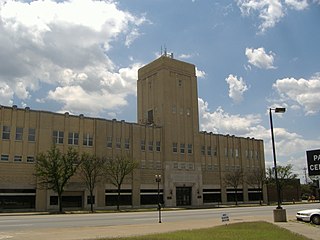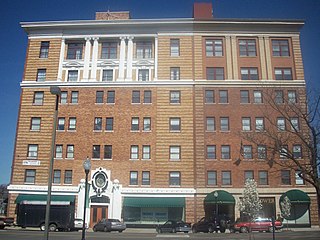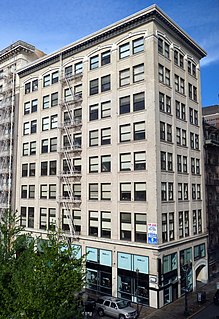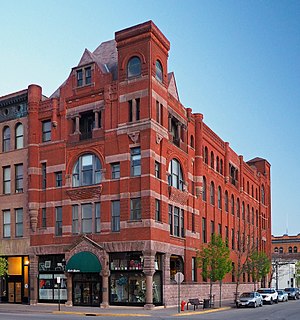
The Old Market is a neighborhood located in downtown Omaha, Nebraska, United States, and is bordered by South 10th Street to the east, 13th Street to the west, Farnam Street to the north and Jackson Street to the South. The neighborhood has many restaurants, art galleries and upscale shopping. The area retains its brick paved streets from the turn of the 20th century, horse-drawn carriages, and covered sidewalks in some areas. It is not uncommon to see a variety of street performers, artists, and other vendors.

The Wholesale District is one of seven designated cultural districts in Indianapolis, Indiana, United States. Located in the south-central quadrant of downtown Indianapolis' Mile Square, the district contains the greatest concentration of 19th-century commercial buildings in the city, including Indianapolis Union Station and the Majestic Building. Contemporary landmarks in the district include Circle Centre Mall and the Indianapolis Artsgarden.

The Elmwood Inn in Perryville, Kentucky is a historic building which served as a mansion, a battlefield hospital in 1862, as an academy during 1891–1925, and later as a restaurant and as a tea house, and then again as a private residence.

The Sears, Roebuck and Company Store, at 800 West Broadway in Louisville, Kentucky, is a building which was listed on the National Register of Historic Places in 1983.

The Albert Kahn Building, formerly New Center Building, is an office building located at 7430 Second Avenue in the New Center area of Detroit, Michigan completed in 1931. The building was listed on the National Register of Historic Places in 1980.

Kaufman-Straus was a local department store that operated in Louisville, Kentucky, from 1879 to 1969. In 1879, local retail clerk Henry Kaufman opened the first store on Jefferson between 7th and 8th. Four years later, Benjamin Straus entered into partnership with Kaufman. In 1887, the Kaufman-Straus store moved to South 4th Street in space leased from the Polytechnic Society of Kentucky. The new flagship store opened in 1903, at 533-49 South 4th Street, designed by local architect Mason Maury. In 1924, Kaufman-Straus was acquired by City Stores Company and the following year the flagship store underwent extensive renovations. City Stores rebranded the company as Kaufman's in 1960. It operated two stores in suburban Louisville at The Mall and Dixie Manor. In 1969, Kaufman's was acquired by L. S. Ayres, and the downtown Louisville store was subsequently closed in 1971.

The Lower Woodward Avenue Historic District, also known as Merchant's Row, is a mixed-use retail, commercial, and residential district in downtown Detroit, Michigan, located between Campus Martius Park and Grand Circus Park Historic District at 1201 through 1449 Woodward Avenue and 1400 through 1456 Woodward Avenue. The district was listed on the National Register of Historic Places in 1999.

The Brisk & Jacobson Store is a historic Italianate-style commercial building in Mobile, Alabama. It was placed on the National Register of Historic Places on March 14, 1973.

The Chicago, Milwaukee, St. Paul and Pacific Freight House, known locally as The Freight House, is a historic building in Downtown Davenport, Iowa, United States. It was listed on the National Register of Historic Places in 1985.

The J.H.C. Petersen's Sons' Store also known as the Petersen Harned-Von Maur Store Building and the Redstone Building, is a historic building in Davenport, Iowa, United States. It was individually listed on the Davenport Register of Historic Properties and on the National Register of Historic Places. In 2020 it was included as a contributing property in the Davenport Downtown Commercial Historic District. The former department store building was modeled on the Rookery Building in Chicago.

The Masonic Temple—Watts, Ritter, Wholesale Drygoods Company Building in Huntington, West Virginia, which has also been historically known as Watts, Ritter Wholesale Drygoods Company Building and more recently known as River Tower, is a commercial building. It is located at 1108 Third Avenue, in Huntington, Cabell County, West Virginia. It was built between 1914 and 1922 as a five-story brick building.

The Odd Fellows Building in Owensboro, Kentucky, also denoted DAOB 86, is a three-story building that was built in 1895. It served historically as a professional building, as a clubhouse, and as a specialty store. It is listed on the National Register of Historic Places.

Central Office Building is a historic building located in downtown Davenport, Iowa, United States. It has been individually listed on the National Register of Historic Places since 1983. In 2020 it was included as a contributing property in the Davenport Downtown Commercial Historic District. It is located in the center of a block with other historic structures. It now houses loft apartments.

The J.H.C. Petersen's Sons Wholesale Building was an historic building located in downtown Davenport, Iowa, United States. It was built in 1910 and listed on the National Register of Historic Places in 1983.

The McBride–Hickey House is a historic building located on the east side of Davenport, Iowa, United States. It has been listed on the National Register of Historic Places since 1983.

The Woodlark Building is a historic commercial building in downtown Portland, Oregon, United States that is listed on the National Register of Historic Places. The nine-story building was designed by Doyle, Patterson & Beach, and constructed in 1911–12. It has been described as "one of Portland's earliest commercial skyscrapers". From its completion until 1924, it was the headquarters of two jointly owned and very similarly named pharmaceutical companies based in Portland, the retail Woodard, Clarke & Company, and the wholesale Clarke-Woodward Company. It was converted into an office building in 1924. The retail space on the ground floor, mezzanine and basement has held a variety of businesses, in succession over the building's history, among the longest-lasting ones being a drugstore (1912–1927), a Sherman Clay piano and music store (1930–1974), and an independent shoe store (2000–2016).

Smulekoffs Furniture Store, also known as the Sinclair Building, New Sinclair Building, Warfield–Pratt–Howell Co. building and the Churchill Drug Co. building, is a historic building located in Cedar Rapids, Iowa, United States. In 1901 Thomas Sinclair had the original section of this five-story brick structure built. It housed the wholesale grocer Warfield–Pratt–Howell Co. and another wholesaler, the Churchill Drug Co. It was the second of several large-scale warehouse buildings that were constructed in this section of the city along the Cedar River. A spur line of the Chicago, Milwaukee, St. Paul and Pacific Railroad was located at the rear of the building. Rosenbaum Furniture Store bought the building in 1925, and it was converted from warehouse use to retail. In 1941 Smulekoffs Furniture Store took over the building and renovated the main floor. They remained here until 2014. The building is slated for apartments on the upper floors and retail on the main floor. It was listed on the National Register of Historic Places in 2016.

The Grocers Wholesale Company Building, also known as the Sears and Roebuck Farm Store, is a historic building located in Des Moines, Iowa, United States. Completed in 1916, this was the first of four warehouses built and owned by Iowa's only and most successful statewide cooperative grocery warehouse. It is possible that it was the first statewide organization of this kind in the country. The cooperative allowed independent grocers to compete against chain stores and survive wholesale grocers' surcharges. They leased their first warehouse after they organized in 1912. Each successive time the cooperative built a new warehouse it was larger and technologically more advanced than the previous one. This particular cooperative grew to include parts of four states: Iowa, southern Minnesota, northern Missouri and eastern Nebraska. They built their second warehouse in 1930 and moved out of this facility. They continued to own this building until 1968, and they leased it out to other firms. The Sears Farm Equipment Store began to occupy the building in 1937 and continued here until 1959. The cooperative became the Associated Grocers of Iowa in the late 1950s, and it continued in existence until 1985. The building was listed on the National Register of Historic Places in 2008.

The Seth Richards Commercial Block, also known as the Lederer-Strauss Building, is an historic building located in downtown Des Moines, Iowa, United States. Its construction represents the transition of Court Avenue from a retail center to the city's wholesale district. Seth Richards had acquired the property that had been the location of several business houses. One of the lots had been owned by the Independent Order of Odd Fellows. The four-story, brick, Romanesque Revival building was constructed in two parts. The commercial blocks at 300-302 and 304-306 were completed and occupied in 1890, and 308-310 was completed and occupied by 1897. Various wholesale clothing firms occupied the various blocks, but by 1920 Lederer, Strauss & Co., Inc., a millinery fabricator and wholesaler, occupied the entire building. The family-run business was sold in 1944 to the Hiersteiners, who incorporated the business as the Landsco Millinery Co. The business was scaled back, and they occupied less of the block, which was filled with other wholesalers by the mid-1950s. In 1957 the Landsco Millinery Co. was liquidated. The building has been converted for other retail uses in the Court Avenue Entertainment District after this area ceased being a wholesale center. It was listed on the National Register of Historic Places in 2005.

The Choate Department Store is a historic commercial building in Winona, Minnesota, United States. It was built in 1881 for Hannibal Choate (1835–1923), an early Winona-based merchant who achieved such regional prominence that he became known as the "merchant prince of southeastern Minnesota". The building was listed on the National Register of Historic Places in 1976 for its local significance in the theme of commerce. It was nominated for its associations with Choate, who pioneered fixed price retail and in-store merchandise displays in the region, and boosted his bottom line by wholesaling to other merchants.




















